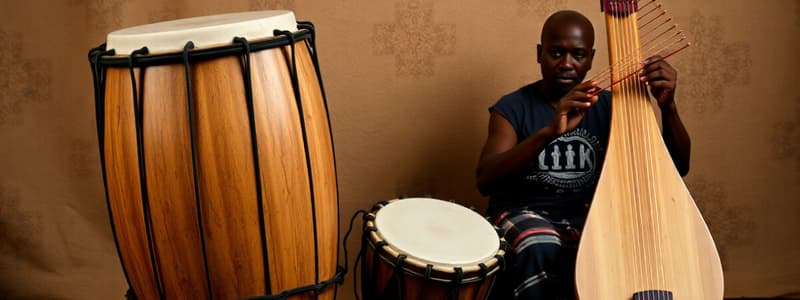Podcast
Questions and Answers
Which aspect of Igbo culture is MOST directly linked to the creation and use of the udu clay drum?
Which aspect of Igbo culture is MOST directly linked to the creation and use of the udu clay drum?
- Their tradition of pottery making for daily utensils.
- Their societal structure where women hold significant artistic roles.
- Their complex religious beliefs requiring instrumental music for rituals.
- Their agricultural practices focused on yam cultivation and harvest celebrations. (correct)
The syncopated rhythm produced by the timbila ensemble of the Chopi tribe is primarily intended to achieve what effect?
The syncopated rhythm produced by the timbila ensemble of the Chopi tribe is primarily intended to achieve what effect?
- To establish a rhythmic foundation for vocal performances.
- To provide a complex musical backdrop for storytelling.
- To create a meditative state for spiritual ceremonies.
- To incite energetic movement and excitement in dancers. (correct)
Among the Bantu peoples who utilize ngoma drums, what primarily distinguishes the drums of the Buganda Kingdom?
Among the Bantu peoples who utilize ngoma drums, what primarily distinguishes the drums of the Buganda Kingdom?
- They possess clan-specific significance, with the king's drums holding paramount importance. (correct)
- They are constructed from unique materials not found elsewhere.
- They are larger in size and produce a wider range of tones compared to other ngoma drums.
- They are exclusively played by royal musicians.
The playing technique of the bow harp, involving damping unused strings, MOST directly contributes to what musical characteristic?
The playing technique of the bow harp, involving damping unused strings, MOST directly contributes to what musical characteristic?
What is the MOST significant function of the mbira within the Shona tribe's cultural practices?
What is the MOST significant function of the mbira within the Shona tribe's cultural practices?
Considering the geographical distribution mentioned in the text, which region BEST represents the area where bow harps are MOST prevalent in Africa?
Considering the geographical distribution mentioned in the text, which region BEST represents the area where bow harps are MOST prevalent in Africa?
Besides its musical function, the udu clay drum possesses an additional practical purpose attributed to its construction. What is this secondary function?
Besides its musical function, the udu clay drum possesses an additional practical purpose attributed to its construction. What is this secondary function?
The timbila performance practice, starting with a solo keyboardist and then incorporating other band members, MOST likely emphasizes what musical element?
The timbila performance practice, starting with a solo keyboardist and then incorporating other band members, MOST likely emphasizes what musical element?
Comparing the mbira to the timbila and ngoma, which instrument is MOST characterized by its portability and personal use in musical practice?
Comparing the mbira to the timbila and ngoma, which instrument is MOST characterized by its portability and personal use in musical practice?
The historical origin of the bow harp in ancient Egypt and Sumer, prior to its adoption across Africa, suggests what about the instrument's dissemination?
The historical origin of the bow harp in ancient Egypt and Sumer, prior to its adoption across Africa, suggests what about the instrument's dissemination?
Flashcards
Udu Drum
Udu Drum
A clay drum made by Igbo women in Nigeria, used for music and as a container.
Igbo People
Igbo People
A farming community in Nigeria known for yam cultivation and cultural festivals.
Timbila
Timbila
A wooden xylophone used by the Chopi tribe in Southern Mozambique, creating syncopated rhythms.
Ngoma Drums
Ngoma Drums
Signup and view all the flashcards
Bow Harp
Bow Harp
Signup and view all the flashcards
Mbira
Mbira
Signup and view all the flashcards
Shona Tribe
Shona Tribe
Signup and view all the flashcards
Clan-Specific Drums
Clan-Specific Drums
Signup and view all the flashcards
Synchronization in Music
Synchronization in Music
Signup and view all the flashcards
Percussion Instruments
Percussion Instruments
Signup and view all the flashcards
Study Notes
Udu Clay Drum of Nigeria
- The Igbo people in Nigeria are primarily farmers
- The yam is a major staple food crop
- The Igbo celebrate the yam harvest with festivals, including parades, dances, and music
- Udu drums are used in Igbo music and ceremonies
- Udu drums are traditionally made by women
- Udu drums are played using a combination of hand slapping and finger tapping
- Udu drums can also be used as storage vessels
Timbila of Southern Mozambique
- The Chopi tribe is known for timbila, a type of xylophone
- Timbila bands are led by one performer who creates the melody
- Other members of the band play in a complex, syncopated rhythm
- The rhythm often involves intricate patterns that encourage energetic dancing
Bow Harps of East Africa
- Bow harps are stringed instruments with a curved wooden bow extending from a hollow resonator
- The bow harp is held across the player's lap
- Strings are plucked with one hand and unused strings dampened by the other hand
- Bow harps originated in ancient Egypt and Sumer
- Bow harps have spread across Africa
- It is a traditional instrument of many different African tribes in Uganda and Sudan
Ngoma Drums of Buganda
- The Bantu people in central, eastern, and southern Africa use ngoma drums
- Ngoma drums have different types in various African regions
- In Buganda, the ngoma drums are unique to each clan
- They are associated with power and are important to the king
Mbira of Zimbabwe
- The Shona tribe uses the mbira, a small thumb piano
- The mbira has staggered metal keys
- It is often played during religious ceremonies
- Mbira is frequently accompanied by a rattle
Studying That Suits You
Use AI to generate personalized quizzes and flashcards to suit your learning preferences.
